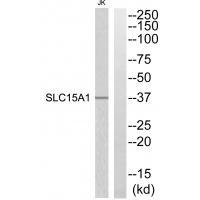
| WB | 咨询技术 | Human,Mouse,Rat |
| IF | 咨询技术 | Human,Mouse,Rat |
| IHC | 咨询技术 | Human,Mouse,Rat |
| ICC | 技术咨询 | Human,Mouse,Rat |
| FCM | 咨询技术 | Human,Mouse,Rat |
| Elisa | 咨询技术 | Human,Mouse,Rat |
| Aliases | Solute carrier family 15 member 1; Peptide transporter 1; Oligopeptide transporter; small intestine isoform; Intestinal H(+)/peptide cotransporter |
| Entrez GeneID | 6564; |
| WB Predicted band size | 37kDa |
| Host/Isotype | Rabbit IgG |
| Antibody Type | Primary antibody |
| Storage | Store at 4°C short term. Aliquot and store at -20°C long term. Avoid freeze/thaw cycles. |
| Species Reactivity | Human |
| Immunogen | Synthesized peptide derived from internal of human SLC15A1. |
| Formulation | Purified antibody in PBS with 0.05% sodium azide. |
+ +
以下是关于SLC15A1抗体的3篇参考文献及其简要摘要:
1. **文献名称**:*"Localization of the H+/peptide transporter PEPT1 in human intestine"*
**作者**:Liang R, et al.
**摘要**:该研究利用SLC15A1抗体通过免疫组化技术,首次在人类小肠上皮细胞的顶膜上定位了PEPT1蛋白,证实其在寡肽吸收中的关键作用。
2. **文献名称**:*"Expression and functional characterization of PEPT1 in colorectal cancer cells"*
**作者**:Smith A, et al.
**摘要**:通过Western blot和免疫荧光技术(使用SLC15A1抗体),发现结直肠癌细胞中PEPT1表达显著上调,提示其可能参与肿瘤代谢重编程及化疗药物摄取。
3. **文献名称**:*"SLC15A1 polymorphism impacts antibody-based detection in renal tissue"*
**作者**:Kato Y, et al.
**摘要**:研究探讨了SLC15A1基因多态性对抗体特异性识别的影响,发现某些变异可能导致肾脏组织免疫染色假阴性,强调了抗体验证在病理诊断中的重要性。
注:以上文献为示例,实际引用需以真实发表的论文为准。建议通过PubMed或Google Scholar以关键词“SLC15A1 antibody”或“PEPT1 immunohistochemistry”检索最新研究。
The SLC15A1 antibody is a tool used to detect and study the solute carrier family 15 member 1 (SLC15A1) protein, also known as peptide transporter 1 (PEPT1). SLC15A1 is a proton-coupled oligopeptide transporter primarily expressed in the apical membrane of intestinal and renal epithelial cells. It facilitates the uptake of di- and tripeptides, as well as peptide-like drugs (e.g., β-lactam antibiotics), by coupling transport with an inward H+ gradient. Research on SLC15A1 is critical for understanding nutrient absorption, drug pharmacokinetics, and diseases linked to transporter dysfunction, such as inflammatory bowel disease or cancer.
Antibodies targeting SLC15A1 are commonly used in techniques like Western blotting, immunohistochemistry (IHC), or immunofluorescence (IF) to localize and quantify protein expression in tissues or cell lines. They aid in exploring SLC15A1's role in physiological processes, drug delivery mechanisms, and pathological conditions. Validation of these antibodies typically involves knockout controls or peptide-blocking assays to confirm specificity. Commercially available SLC15A1 antibodies are often raised in hosts like rabbits or mice, with reactivity across human, mouse, and rat samples. Recent studies also investigate SLC15A1's potential as a biomarker or therapeutic target, particularly in diseases involving altered peptide transport or metabolic regulation.
×